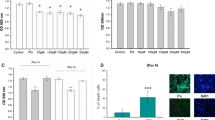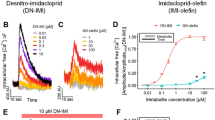Abstract
Recently, acetylcholinesterase (AChE, EC 3.1.1.7) has received increased attention in the field of environmental sciences. Evaluation of the effects of environmental contaminants on AChE enzymatic activity not only can reflect, to some extent, the interference with the nervous system, but also can be used for monitoring pollution. Our previous study showed that 2,3,7,8-tetrachlorodibenzo-p-dioxin (2,3,7,8-TCDD) suppressed neuronal AChE enzymatic activity via transcriptional downregulations mediated by aryl hydrocarbon receptor. In the present study, the effects of several other dioxin-like compounds (DLCs) on neuronal AChE activity were determined, including 1,2,3,7,8-pentachlorodibenzo-p-dioxin, 2,3,7,8-tetrachlorodibenzofuran, 2,3,4,7,8-pentachlorodibenzofuran, and 2,3,7,8-tetrabromodibenzo-p-dioxin. The results showed that the enzymatic activity of AChE was significantly decreased by approximately 15–30 % after exposure to a certain concentrations of the DLCs, whereas incubating neuronal cell lysates directly with these DLCs did not inhibit AChE enzyme. Subsequent molecular mechanism study showed that these chemicals could decrease ACHE promoter activity, as well as AChE T mRNA expression, thereby suggesting the involvements of transcriptional regulation in these effects. These findings on DLCs are similar with those on 2,3,7,8-TCDD, pointing to the possibility that exposure to dioxin and DLCs, which frequently coexist in the contaminated environments, may concurrently interfere with the cholinergic functions via AChE.




Similar content being viewed by others
References
Ahmed M, Rocha JBT, Mazzanti CM et al (2007) Malathion, carbofuran and paraquat inhibit Bungarus sindanus (krait) venom acetylcholinesterase and human serum butyrylcholinesterase in vitro. Ecotoxicology 16:363–369
Ahmed M, Latif N, Khan RA, Ahmad A (2012) Toxicological effect of herbicides (diuron and bentazon) on snake venom and electric eel acetylcholinesterase. Bull Environ Contam Toxicol 89:229–233
Ahmed RG (2011) Perinatal TCDD exposure alters developmental neuroendocrine system. Food Chem Toxicol 49:1276–1284
Behnisch PA, Hosoe K, Sakai S (2003) Brominated dioxin-like compounds: in vitro assessment in comparison to classical dioxin-like compounds and other polyaromatic compounds. Environ Int 29:861–877
Bradford MM (1976) A rapid and sensitive method for the quantitation of microgram quantities of protein utilizing the principle of protein-dye binding. Anal Biochem 72:248–254
Bronicki LM, Jasmin BJ (2012) Trans-acting factors governing acetylcholinesterase mRNA metabolism in neurons. Front Mol Neurosci 5:36
Denison MS, Nagy SR (2003) Activation of the aryl hydrocarbon receptor by structurally diverse exogenous and endogenous chemicals. Annu Rev Pharmacol Toxicol 43:309–334
Ellman GL, Courtney KD, Andres V, Featherstone RM (1961) A new and rapid colorimetric determination of acetylcholinesterase activity. Biochem Pharmacol 7:88–95
Fleschjanys D, Berger J, Gurn P et al (1995) Exposure to polychlorinated dioxins and furans (PCDD/F) and mortality in a cohort of workers from a herbicide-producing plant in Hamburg, Federal Republic of Germany. Am J Epidemiol 142:1165–1175
Fulton MH, Key PB (2001) Acetylcholinesterase inhibition in estuarine fish and invertebrates as an indicator of organophosphorus insecticide exposure and effects. Environ Toxicol Chem 20:37–45
Hayakawa K, Takatsuki H, Watanabe I, Sakai S (2004) Polybrominated diphenyl ethers (PBDEs), polybrominated dibenzo-p-dioxins/dibenzofurans (PBDD/Fs) and monobromo-polychlorinated dibenzo-p-dioxins/dibenzofurans (MoBPXDD/Fs) in the atmosphere and bulk deposition in Kyoto, Japan. Chemosphere 57:343–356
Li H, Yu L, Sheng G, Fu J, Peng PA (2007) Severe PCDD/F and PBDQ/F pollution in air around an electronic waste dismantling area in China. Environ Sci Technol 41:641–5646
Litten S, McChesney DJ, Hamilton MC, Fowler B (2003) Destruction of the World Trade Center and PCBs, PBDEs, PCDD/Fs, PBDD/Fs, and chlorinated biphenylenes in water, sediment, and sewage sludge. Environ Sci Technol 37:5502–5510
Massoulié J (2002) The origin of the molecular diversity and functional anchoring of cholinesterases. Neurosignals 11:130–143
Mdegela RH, Mosha RD, Sandvik M, Skaare JU (2010) Assessment of acetylcholinesterase activity in Clarias gariepinus as a biomarker of organophosphate and carbamate exposure. Ecotoxicology 19:855–863
Olsman H, Engwall M, Kammann U et al (2007) Relative differences in aryl hydrocarbon receptor-mediated response for 18 polybrominated and mixed halogenated dibenzo-p-dioxins and -furans in cell lines from four different species. Environ Toxicol Chem 26:2448–2454
Richetti SK, Rosemberg DB, Ventura-Lima J, Monserrat JM, Bogo MR, Bonan CD (2011) Acetylcholinesterase activity and antioxidant capacity of zebrafish brain is altered by heavy metal exposure. Neurotoxicology 32:116–122
Sailaja BS, Cohen-Carmon D, Zimmerman G, Soreq H, Meshorer E (2012) Stress-induced epigenetic transcriptional memory of acetylcholinesterase by HDAC4. Proc Natl Acad Sci U S A 109:e3687–e3695
Schecter A, Birnbaum L, Ryan JJ, Constable JD (2006) Dioxins: an overview. Environ Res 101:419–428
Shaltiel G, Hanan M, Wolf Y et al (2013) Hippocampal microRNA-132 mediates stress-inducible cognitive deficits through its acetylcholinesterase target. Brain Struct Funct 218:59–72
Soreq H, Seidman S (2001) Acetylcholinesterase—new roles for an old actor. Nat Rev Neurosci 2:294–302
Van den Berg M, Birnbaum LS, Denison MS et al (2006) The 2005 World Health Organization reevaluation of human and mammalian toxic equivalency factors for dioxins and dioxin-like compounds. Toxicol Sci 93:223–241
Van den Berg M, Denison MS, Birnbaum LS et al (2013) Polybrominated dibenzo-p-dioxins, dibenzofurans, and biphenyls: inclusion in the toxicity equivalency factor concept for dioxin-like compounds. Toxicol Sci 133:197–208
Velan B, Kronman C, Ordentlich A et al (1993) N-glycosylation of human acetylcholinesterase: effects on activity, stability and biosynthesis. Biochem J 296:649–656
Wang LC, Hsi HC, Wang YF, Lin SL, Chang-Chien GP (2010) Distribution of polybrominated diphenyl ethers (PBDEs) and polybrominated dibenzo-p-dioxins and dibenzofurans (PBDD/Fs) in municipal solid waste incinerators. Environ Pollut 158:1595–1602
Wang ZY, Zhao J, Li FM, Gao DM, Xing BS (2009) Adsorption and inhibition of acetylcholinesterase by different nanoparticles. Chemosphere 77:67–73
WHO (2010) Dioxins and their effects on human health. Fact sheet 225.
Winer J, Jung CKS, Shackel I, Williams PM (1999) Development and validation of real-time quantitative reverse transcriptase-polymerase chain reaction for monitoring gene expression in cardiac myocytes in vitro. Anal Biochem 270:41–49
Xie HQ, Xu HM, Fu HL et al (2013) AhR-mediated effects of dioxin on neuronal acetylcholinesterase expression in vitro. Environ Health Perspect 121:613–618
Acknowledgments
We thank Angela C. Zhang for comments during manuscript preparation. This work was supported by the National Natural Science Foundation of China (grants 20921063, 21177150, and 21277168) and the Chinese Academy of Sciences Key Program of Knowledge Innovation (KZCX2-EW-411).
Conflict of interest
The authors have no conflicts of interest to declare.
Author information
Authors and Affiliations
Corresponding authors
Rights and permissions
About this article
Cite this article
Xu, HM., Xie, H.Q., Tao, WQ. et al. Dioxin and Dioxin-Like Compounds Suppress Acetylcholinesterase Activity via Transcriptional Downregulations In Vitro. J Mol Neurosci 53, 417–423 (2014). https://doi.org/10.1007/s12031-013-0167-5
Received:
Accepted:
Published:
Issue Date:
DOI: https://doi.org/10.1007/s12031-013-0167-5




